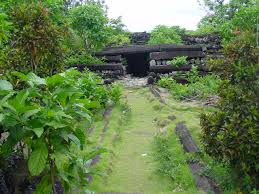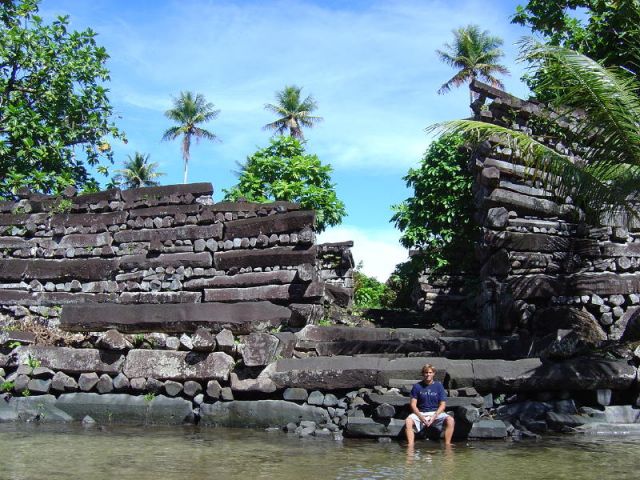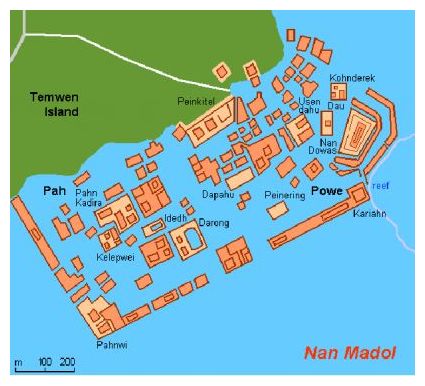Research by Jaime Ortega.

One of the most fantastic and the real-life archaeological sites in the world is Nan Madol. Recently, around a wave of controversy and debate, particularly in connection with the publications to its origins.
Nan Madol — that’s 92 man-made island near the island of Ponape, in which the unknown builders have erected many stone buildings, among which are the palaces, temples, forts, ritual pools. It even has its own underground prison. Island for its canals, replacing streets, reminiscent of Venice. Nan Madol — an artificial archipelago, erected in the middle of the Pacific Ocean — is something amazing. So do not put nothing esoteric in the capital of Nan Madol the legendary continent of the Pacific, known as the “Pacifis” or by analogy with Atlantis — “Pacific Atlantis.”
In the problems of Nan Madol are key questions — Who, when and why erected island? What was his purpose? And how is it related to the history of modern Polynesia? Answers to these questions yet. And it is doubtful that in the near future a mystery of the island will be solved. We can only be satisfied with the theories and hypotheses.
Unfortunately, official science has not found time to somehow lift the veil of secrecy that hangs over the Nan Madol. I now turn to the myths and legends of the Polynesians and the works of unique and even curious figures, what are, for example Helena Blavatsky — founder of the so-called Theosophical Society and Macmillan Brown. The last, Nan Magol was the capital of the rulers of the Pacific continent. This mysterious continent, which, by the way, is called Pacifis and Lemuria extended: from north to south of the Hawaiian Islands to the Marianas. In the east, it was limited to Easter Island.
Extreme western region of esoteric attributed to the island of Fiji. And there is some sense. After all, Fiji also has stone buildings, its appearance similar sanctuaries Nan Magol. As a result of the flood caused believed Pacifis supporters, the fall of the celestial body, the continent sank into the depths of the ocean. Nan Magol, as well as Fiji, Hawaii and Easter Island later, with the lowering of the Pacific Ocean up to the surface.
As with any theory, this view of the mystery of Nan Magol has the right to exist, especially as scientific research proves otherwise. Indeed, the very existence theory Pacifis also lacked a factual evidence. Therefore, the controversy surrounding the Nan Madol will continue.
(N.Morgan) On our exploration of the strange and beautiful, I found an under water ruin called Nan Mandol,Micronesian. The mystery that surrounds this ruin was intriguing enough for me to want to know more. Some believe that aliens built this wonderous city. Again, I marvel at the ingenuity of the ancestors and their never ending en devour to improve their way of life. One of the greatest archeological mysteries in the world, the lost city of Nan Madol. Build on an ancient corals reef and covering more than 11 square miles, this ancient city is made up hundreds of artificial islets, intersected by numerous man made canals.
Even more curious, many of the city’s larger islands are connected by submerged tunnels. The mysterious Nan Madol is built entirely out of gigantic magnetized basalt crystals, some weighing as much as fifty tons. In fact, the entire city contains an estimated 250 million tons of the prismatic basalt rock. Native mythology suggests that the stones were magically flown through the air and placed in the city.

Rough map of Nan Madol in the Federated States of Micronesia.
According to the Weather Channel:
Off the shores of a tiny island in the middle of the vast Pacific Ocean are the ruins of an ancient civilization. The remains of Nan Madol are the only standing monument of a civilization built entirely over open water, on a coral reef.
The eerie abandoned stone structures are said to have inspired science-fiction writer H. P. Lovecraft to create a similar sunken city that was home to the monster Cthulhu, says Atlas Obscura.
In reality, Nan Madol was once home to the Saudeleur, who ruled the island of Pohnpei for more than a millennium, reported Smithsonian Magazine. The 92 artificial islands of Nan Madol are thought to have been constructed over the course of several centuries, and then eventually abandoned after 1,000 years of habitation.
Rufino Mauricio, Pohnpei’s only archaeologist, has dedicated his life to studying and preserving the ruins, which are built of 750,000 tons of black basaltic rock.
“We don’t know how they brought the columns here and we don’t know how they lifted them up to build the walls. Most Pohnpeians are content to believe they used magic to fly them,” Mauricio told Smithsonian.
He added that given the size of Pohnpei’s population at the time – fewer than 30,000 people – the construction of Nan Madol is an even larger and more remarkable effort than the Great Pyramids were for the ancient Egyptians.

(Image)

Impressive in their own right, these ruins represent the remains of megalithic architecture on an unparalleled scale in Micronesia.
Evidence of the earliest human activity dates back to the first or second century BC. The construction of artificial islets started probably about 8th and 9th century AD. However, the megalithic structures were built in period of 12th to 13th century, about the same time as the stone construction of the Cathedral of Notre Dame in Paris, or Angkor Wat in Cambodia.
The complex of Nan Madol is constructed on a series of artificial islets in the shallow water next to the eastern shore of the Pohnpei island. The site encloses an area approximately 1.5 km long by 0.5 km wide and it contains nearly 100 artificial islets.

Nan Madol seems to have housed the ruling elite caste of Saudeleur dynasty. It was a political and ceremonial seat of power. As a means of control of their subjects Saudeleur dynasty had succeeded in uniting the clans of Pohnpei. The rulers forced local chieftains to leave their home villages and move to the city where their activities could be more closely observed.
Most of the islets served as residential area, however some of them served special purpose, such as food preparation, coconut oil production or canoe construction. Madol Powe, the mortuary sector, contains 58 islets in the northeastern area of Nan Madol. The centerpiece of the whole complex is the royal mortuary at the islet of Nandauwas, with its 7.5m high walls surrounding the central tomb enclosure.
The population of Nan Madol was probably more than 1000 at a time when whole population of Pohnpei barely reached 25,000. There are no sources of fresh water or possibilities to grow food on Nan Madol so all supplies had to be brought in from the mainland. The population of the city probably included a large number of commoner servants.
Nan Madol is the biggest center of the culture which left numerous other megalithic structures scattered on neighboring shores and on main island of Pohnpei; it all can be found in the area of about 18 square kilometers.

According to local legend, the stones used in the construction of Nan Madol have been flown to the location by means of black magic. Archeologists have located several possible quarry sites on the main island, however the exact method of transportation of construction material is still not determined.
Lovecraft used the story of the ruins as the basis for his R’lyeh, a fictional sunken city and home to Cthulhu, appearing in the short story “Call of Cthulhu”, as described as: “The nightmare corpse-city of R’lyeh … was built in measureless eons behind history by the vast, loathsome shapes that seeped down from the dark stars. There lay great Cthulhu and his hordes, hidden in green slimy vaults . . . until the end.”
The real island of Pohnpei is also mentioned in the story.
Nan Madol had been abandoned by the time the first Europeans arrived, early in the 19th century, most likely declining at the time of the fall of the Saudeleur Dynasty in about 1450. Some have claimed that the ruins are the lost islands of Lemuria, although there is no scientific backing for this claim (or, for that matter, for the existence of Lemuria at all).




